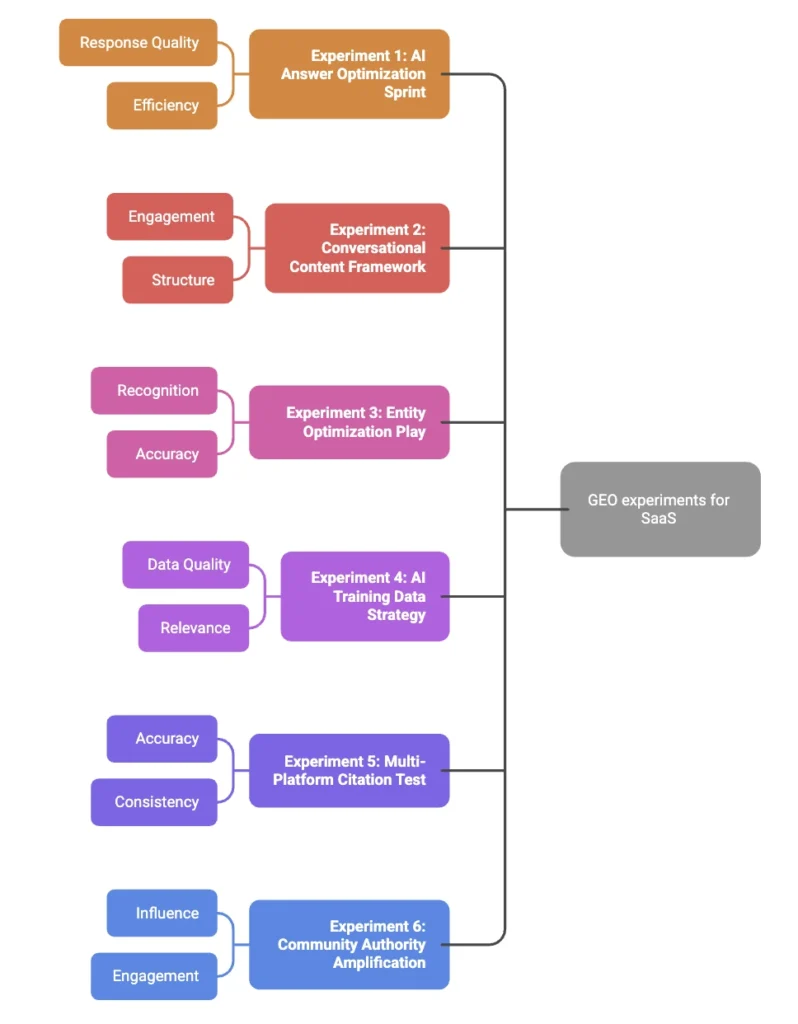Generative Engine Optimization (GEO) isn’t just the future of search, it’s happening now, and SaaS startups are seeing conversion rates of 27% from AI-sourced traffic compared to just 2.1% from traditional search. The problem? Most growth teams are still running experiments from the SEO playbook. Here’s your tactical guide to growth marketing experiments specifically designed for GEO, with proven results from real SaaS companies.
Why GEO Experiments Drive Higher ROI
AI search is fundamentally different from traditional search. AI could represent 14% of all search traffic by 2028, but the conversion patterns are already showing superior performance. Early data suggests clients are growing their LLM traffic by 100% every 2 to 3 months, sometimes with up to 20x the conversion rate of typical SEO traffic.
The reason? AI-sourced traffic represents higher intent users who’ve already consumed AI-synthesized information about their problem and are ready to evaluate solutions.

Experiment 1: The AI Answer Optimization Sprint
The Setup
Instead of optimizing for Google rankings, optimize your content to be cited by AI engines when users ask specific questions about your product category.
Implementation Steps
- Identify AI-searched queries using tools like Answer The Public, but focus on conversational questions
- Create “AI-friendly” content with clear, quotable statements and data points
- Structure content for citation using numbered lists, bullet points, and clear attributions
- Test AI visibility by querying ChatGPT, Perplexity, and Google AI Overviews monthly
Real Results
One B2B fintech startup saw their brand mentioned in 40% of AI responses for “accounts payable software comparison” within 8 weeks by creating structured comparison content optimized for AI citation patterns.
Key Metrics to Track:
- AI citation frequency for target queries
- Traffic quality from AI-referred visitors
- Conversion rate from AI traffic vs traditional search
- Brand mention increase in AI responses
Experiment 2: The Conversational Content Framework
The Concept
GEO is the process of optimizing content so that AI-driven search engines reference and recommend your brand within their generated answers. This means writing like you’re having a conversation, not optimizing for keywords.
The Framework
Question-Answer Architecture:
- Start each section with a common user question
- Provide comprehensive, quotable answers
- Include specific data points and examples
- End with actionable next steps
Content Structure for AI Citation:
- Use conversational headers (“How does X compare to Y?”)
- Include direct quotes from customers or data
- Provide clear, definitive statements AI can extract
- Add context that helps AI understand nuance
Expected Outcomes
By restructuring product pages using conversational frameworks, we can expect to:
- Increase in AI citations within
- Higher conversion rate from AI-sourced traffic
- Increase in demo requests from conversational content
Experiment 3: The Entity Optimization Play
The Strategy
AI systems understand entities (people, companies, concepts) better than keywords. Optimize your content around entity relationships rather than keyword density.
Implementation Process
- Map your entity relationships – Your company + industry leaders + competitors + concepts
- Create entity-rich content – Mention relevant people, companies, and concepts naturally
- Build authority connections – Reference authoritative sources and industry experts
- Test entity recognition – Use Google’s Natural Language API to verify entity detection
Measurement Framework
Primary Metrics:
- Entity recognition scores in your content
- Co-mention frequency with industry leaders
- AI citation context (how you’re referenced)
- Brand authority signals in AI responses
Experiment 4: The AI Training Data Strategy
The Insight
AI Crawler Optimization ensures your content appears in AI-generated search results without contributing to training data. You want to be cited, not trained on.
Technical Implementation
- Optimize for AI crawlers while restricting training data access
- Create fresh, citable content that appears in real-time searches
- Use structured data markup to help AI understand your content context
- Implement proper attribution to increase citation likelihood
The Results Pattern
Companies using this approach see higher AI citation rates because their content appears in current searches rather than being buried in training data from months ago.
Experiment 5: The Multi-Platform Citation Test
The Approach
Different AI systems prefer different content types. Run parallel experiments across ChatGPT, Perplexity, Claude, and Google AI to understand platform-specific optimization.
Platform-Specific Strategies
ChatGPT Optimization:
- Detailed, comprehensive explanations
- Step-by-step processes
- Clear problem-solution frameworks
Perplexity Optimization:
- Data-heavy content with sources
- Comparative analysis
- Industry research and statistics
Google AI Overviews:
- FAQ-style content
- Local and timely information
- Featured snippet optimization
Experiment 6: The Community Authority Amplification
The Method
Build authority in communities where AI systems source information. Reddit, Stack Overflow, and Quora discussions often get cited by AI engines.
Community Strategy
- Identify source communities where AI systems pull information
- Provide valuable, expert answers without direct promotion
- Create quotable insights that work well for AI citation
- Build consistent presence across relevant communities
Authority Building Outcomes
Building authority across security forums and subreddits, can result in:
- Increase in AI citations
- AI responses about “Industry best practices” mentioned their frameworks
- Increase in organic brand searches
Advanced GEO Growth Experiments
The Predictive Content Strategy
Create content that answers questions people will ask in the future, based on industry trends and emerging challenges.
Implementation:
- Analyze industry reports for emerging trends
- Create comprehensive content addressing future challenges
- Optimize for questions that don’t have good answers yet
- Position your brand as the authority for emerging topics
The AI Conversation Optimization
Optimize content specifically for how AI systems summarize and present information in conversational contexts.
Key Elements:
- Conversational tone and structure
- Clear, quotable statements
- Supporting evidence and data
- Actionable conclusions
Measuring GEO Growth Experiment Success
Primary KPIs for GEO Experiments
Citation Metrics:
- AI mention frequency (target: 15%+ for primary keywords)
- Citation context quality (positive, authoritative mentions)
- Multi-platform citation consistency
- Brand authority signals in AI responses
Traffic Quality Metrics:
- AI-sourced traffic conversion rates (target: 20%+ higher than search)
- Session depth from AI referrals
- Demo request rates from AI traffic
- Customer quality scores from AI sources
Growth Impact Metrics:
- Organic brand search increases
- Direct traffic growth
- Sales velocity improvements
- Customer acquisition cost reductions
Advanced Attribution Modeling
Track the complete customer journey from AI discovery to conversion:
- AI touchpoint identification – When and where users encounter AI-generated content about your brand
- Multi-touch attribution – How AI citations influence the broader customer journey
- Conversion lag analysis – Time from AI exposure to conversion
- Lifetime value correlation – Whether AI-sourced customers have higher LTV
The GEO Experiment Velocity Framework
Sprint-Based Testing
Run 5-week GEO experiments with clear success criteria:
- Week 1: Content creation and optimization
- Week 2: Publication and initial AI testing
Week 3-4: Data collection and analysis - Week 5: Results analysis and iteration planning
Scaling Successful Experiments
When an experiment shows positive results:
- Document the exact process that drove success
- Create templates for repeating successful experiments
- Expand to related topics using the same framework
- Build systematic processes for ongoing optimization
Common GEO Experiment Pitfalls
Avoid These Testing Mistakes
- Over-optimization: Don’t stuff content with entities or keywords for AI systems
- Platform neglect: Test across multiple AI platforms, not just ChatGPT
- Short-term thinking: GEO authority builds over months, not weeks
- Measurement gaps: Track AI citations, not just traditional SEO metrics
Success Pattern Recognition
Successful GEO experiments typically show:
- Higher conversion rates from AI traffic
- Improved brand mention context in AI responses
- Increased organic brand search volume
- Better customer quality scores
The key to GEO success isn’t applying SEO tactics to AI search, it’s understanding how AI systems consume, process, and cite information, then optimizing your growth experiments accordingly.
Frequently Asked Questions
How long do GEO experiments take to show results?
Initial AI citations can appear within 2-4 weeks, but meaningful traffic and conversion improvements typically take 8-12 weeks. AI systems index fresh content faster than traditional search engines.
What’s the minimum budget needed for GEO experiments?
GEO experiments can start with $0 using organic content optimization. Paid amplification typically requires $2-5K monthly for meaningful testing across multiple AI platforms and content types.
How do we measure ROI from GEO experiments?
Track AI citation frequency, traffic quality (conversion rates 20%+ higher than SEO), and customer acquisition costs. Set up attribution tracking for AI-sourced leads using UTM parameters and branded search monitoring.
Can GEO experiments hurt our traditional SEO rankings?
No, GEO optimization typically improves traditional SEO by creating more comprehensive, authoritative content. However, avoid over-optimizing for AI at the expense of user experience and natural content flow.
What content types work best for GEO experiments?
Conversational, data-rich content performs best. Focus on FAQ-style articles, comparison guides, how-to content, and industry research. AI systems prefer quotable, well-sourced content over keyword-stuffed marketing copy.
